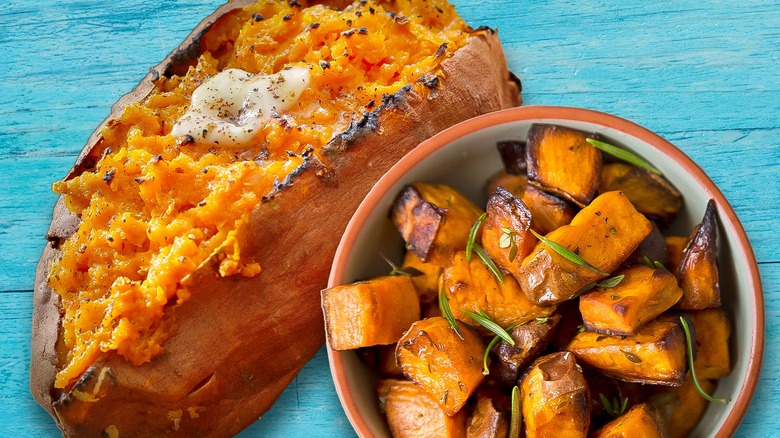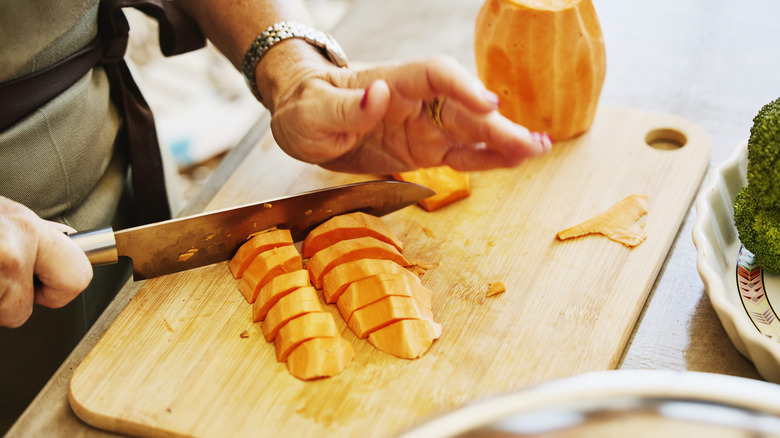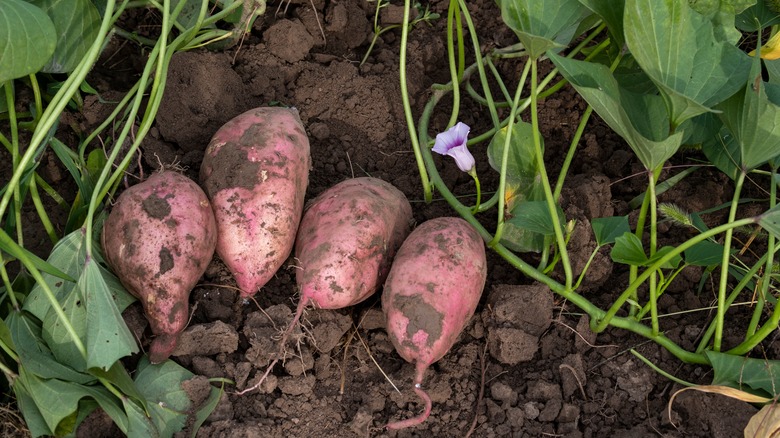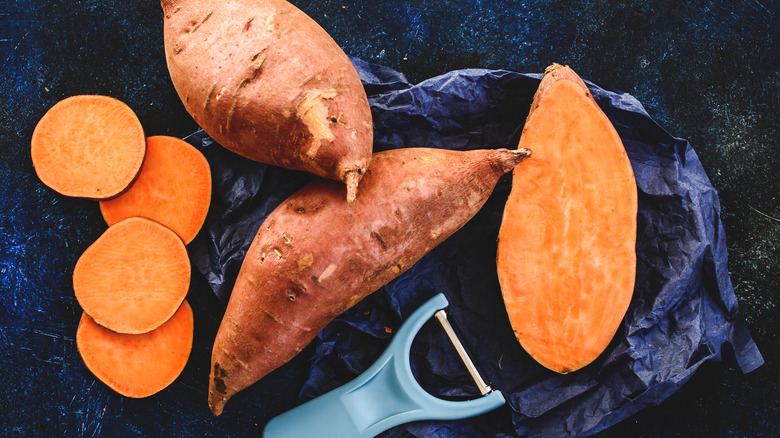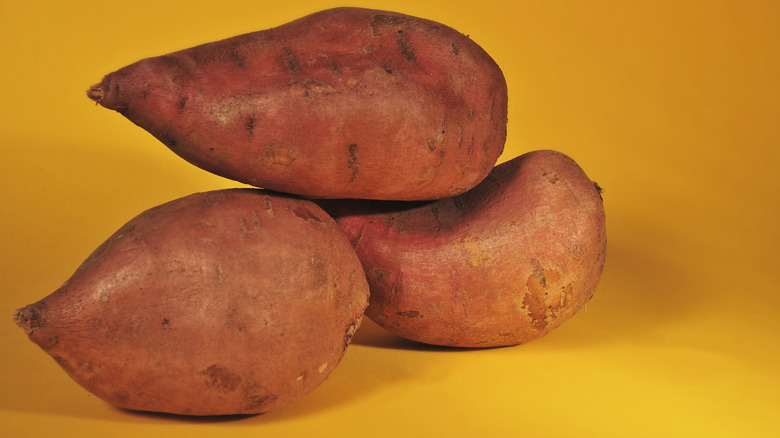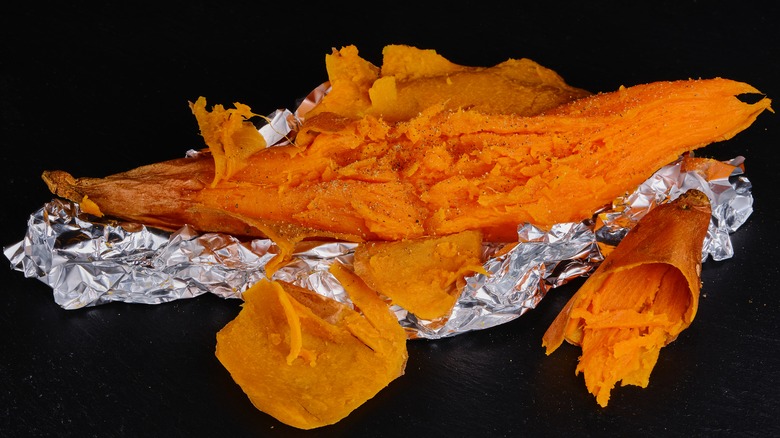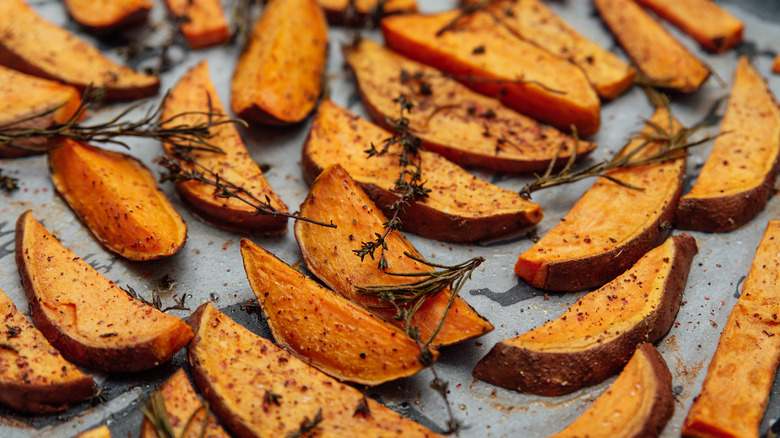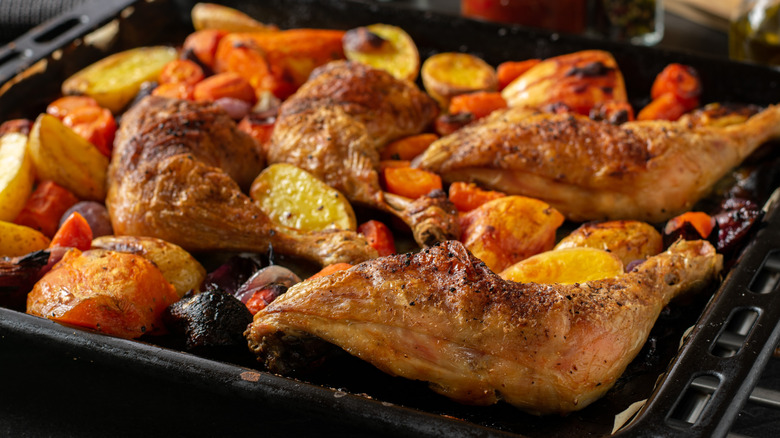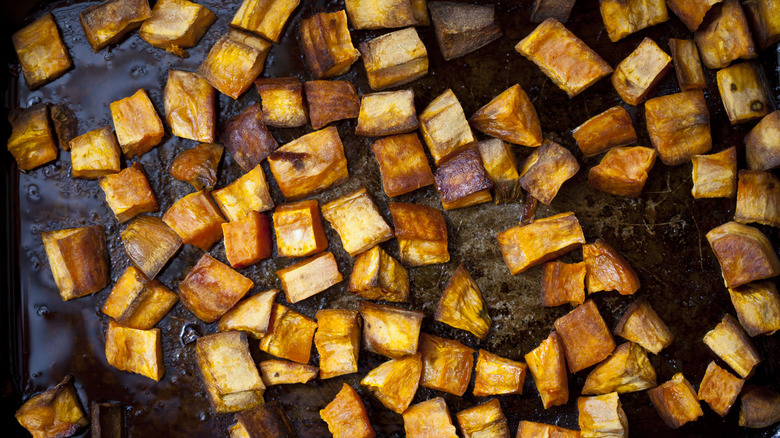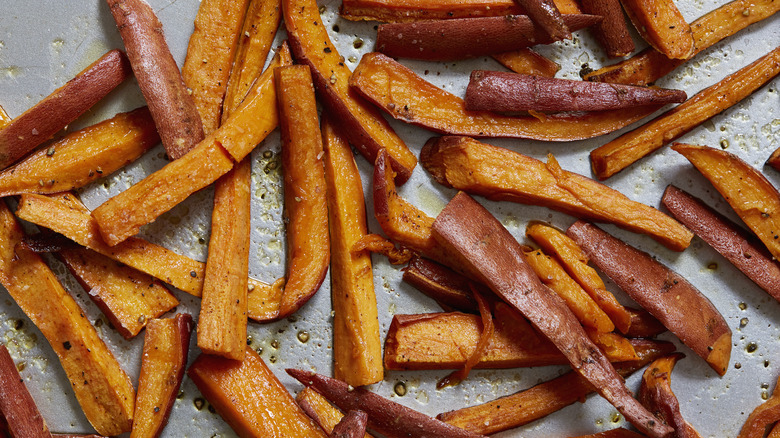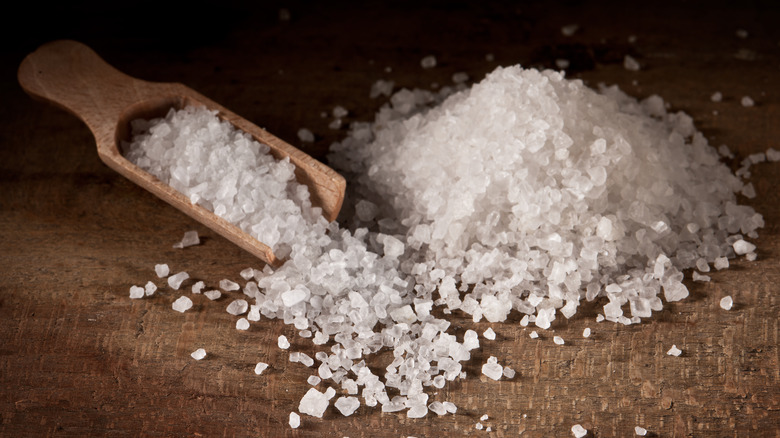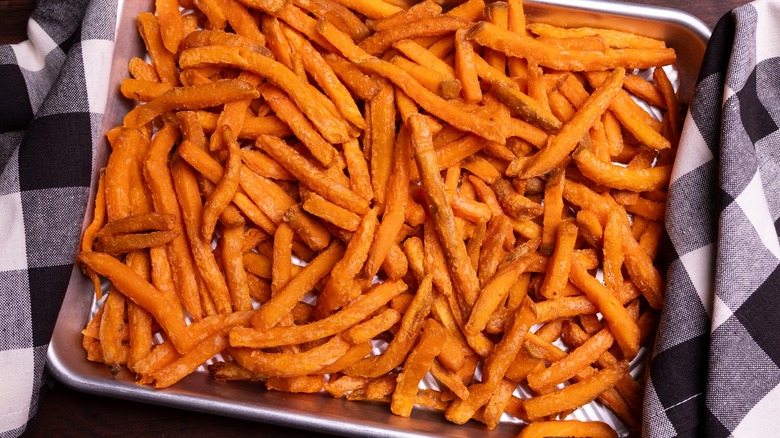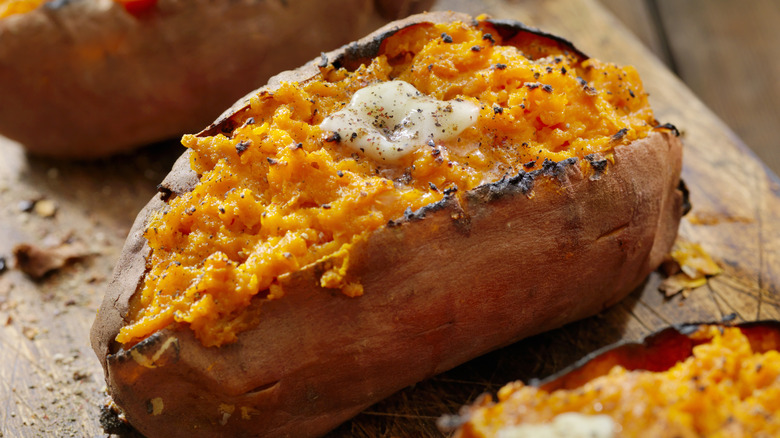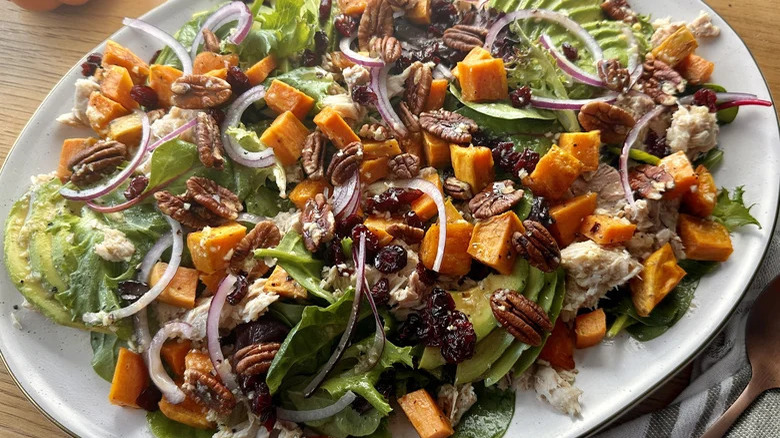13 Tips You Need For The Best Roasted Sweet Potatoes
When it comes to root vegetables, sweet potatoes are sweet and earthy. They're versatile, and you can use them for savory dishes and as desserts. Roasting the veggies can be a fantastic way to maximize their flavor. We consulted with a couple of cooking experts to get the tips you need for the best roasted sweet potatoes. Chef Richard LaMarita has a decades-long culinary career and is currently the chef-instructor of Plant-Based Culinary Arts at the Institute of Culinary Education in New York City. Jessica Randhawa is the head chef, recipe creator, photographer, and writer behind The Forked Spoon. Her website has over 1,000 family-friendly recipes from different cultures.
"Sweet potatoes are high in sugar and moisture, therefore when roasting, they can come out mushy, soggy, and not at all like delicious, crispy french fries," says LaMarita. "Don't fret. With a little understanding and some good culinary tips, your sweet potatoes can measure up with the most perfect fries. It basically comes down to space, spice, starch, and temperature."
Once you get the culinary basics of this particular vegetable down, you'll be able to make many types of roasted sweet potato-based dishes. You'll find a lot of creative freedom based on the results you're looking for or how you ultimately want to use them. "One of life's great pleasures is a delicious, heaping bowl of beautifully roasted sweet potatoes, and with these tips, you will soon be an expert," says LaMarita.
Cut the sweet potato evenly
No matter what shape you cut the spuds, you must keep a consistent size. This isn't the time to quickly chop into mismatched pieces. Unlike potatoes, which are watery, these vegetables are dense and dry. "For the best texture, make sure to cut your sweet potatoes into even-sized pieces. This ensures that all pieces cook at the same rate and you don't end up with some pieces overcooked and others still hard," says Jessica Randhawa. Believe us, we've made the mistake ourselves — biting into a soft, buttery piece and then taking another bite only to find it firm and unpleasant.
"I recommend using a sharp chef's knife for cutting and aiming for 1-inch cubes or slices, depending on your preference," notes Randhawa. This is particularly helpful due to the vegetable's firmness. You don't want to hack away at it with a dull knife and have a mishap. The consistent pieces also ensure even seasoning. If you're roasting the root vegetables whole, keep those at similar sizes, too. A giant sweet potato will remain hard in the center if cooked with smaller-sized ones. Factoring in the evenness before cooking means you save time; you won't have to do extra work of removing cooked pieces and allowing more roasting time for the larger ones or spuds.
Thoroughly wash them before cooking
Sweet potatoes are root vegetables that grow in the ground. Whether you purchase them at the farmers market or grocery store or grow them in your home garden, you'll likely see dirt on them with the naked eye. It's important to clean sweet potatoes before cooking, but it's not just dirt you want to wash off. It's also any bacteria or pesticides. Start by rinsing them under running water or filling a large bowl with water and letting them soak. This step will get a lot of the dirt off. You don't need to use any cleaners like soap, but you can opt for vinegar if you want something stronger than water alone. Use a paper towel, dish towel, or potato scrubber to remove the remaining dirt.
These are durable tubers, so you don't have to worry about them falling apart during scrubbing like you might if washing mushrooms. After rubbing off the dirt, get them one last rinse. You might have dislodged caked-on dirt with the paper towel, but the last rinse lets it wash off into the sink. This is also the time to remove any stringy bits from the roots. Then dry it with a dish towel or let it air dry before roasting. You don't want the extra moisture, especially if you want a crispier, browner roast for fries.
Choose good, healthy sweet potatoes
Like any vegetable, you want to pick healthy spuds, allowing you to avoid the one big mistake people make with sweet potatoes. This starts at the purchasing stage. When buying them, avoid tubers with cuts or bruises. Skip them if they seem soft or if they're sprouting. Both these instances mean it's an old veggie nearing its expiration date. You don't have to sift through to find the most aesthetically pleasing, but the more beat up your sweet potato is, the older it likely is. If the tuber has a small spot or two, you can remove any damage and use the remainder. But if it's excessive, avoid buying it altogether. Choose similar-sized spuds for the best results.
Because these vegetables don't rot as quickly or in the same fashion as zucchini or a leafy green, you might forget about them in your pantry or cabinet. For an enjoyable meal, purchase sweet potatoes with a dish in mind rather than letting them sit around for weeks. This means it'll be as fresh as possible for your food. If they do happen to sit around, apply the same techniques to check for spots and bruising. Don't refrigerate them because they can become dry. Store them in a dark, dry, cool place rather than leaving them on your countertop exposed to the sun and other elements.
Trying freezing them first
To make the best baked sweet potatoes, you might want to try freezing them first. This tip requires some planning; it won't work if you rush to serve dinner. It's best to prep these the day before cooking them so you have enough time to complete all the steps. First, prep and wash them like you would for any potato dish. Then, freeze the tubers for at least three hours. Once hardened, let them thoroughly thaw. Season them as desired, cover each one in aluminum foil, and then bake. You'll start with a lower temperature until they become tender, and then turn up the heat for the final roasting stretch.
It all boils down to science. The veggie's water content expands during the freezing process, rupturing the cell walls. This gives them a soft texture, sweeter taste, and more notable aroma. The amylase enzyme converts starch into sugar, maximizing the root vegetable's natural sweetness, which you can expand on during high-temperature roasting. Since these are naturally sweeter, these frozen to caramelized spuds are perfect for a dessert like brûléed sweet potatoes and ice cream.
Soak or roast them in water
There are a couple of water-related hacks to heighten your roasted yellow-orange tubers. TikToker @shesgotflavor has a simple way to make your spuds restaurant quality — wrap the spuds in aluminum foil and add a few tablespoons of water while roasting. That's it. The water does all the work. This moisture hack for roasting sweet potatoes gives them a juicy, decadent, fluffy texture that maximizes their natural sweetness. After roasting, slice them in half and add any seasoning. In the video, the TikToker suggests vegan butter, cinnamon, honey, and vanilla for a dessert rendition you'll drool over.
For a different H2O method, try soaking sweet potatoes in cold water for 30 minutes before roasting them. Peel them or leave the skin on, cut them, and then place them in the water. Richard LaMarita says he prefers to keep the skins on since they are fiber-rich. "The soaking helps to release some starch in the potatoes, which allows for a crispier texture ... it is important to drain completely and dry them with a towel or air-dry before roasting." This is because you're aiming for a crisp texture, where excess moisture can quickly make it mushy. "Toss with oil, salt, and pepper before they go into the oven," says LaMarita.
Have fun with the seasoning
These gorgeous, colorful spuds are adaptable to any seasoning, whether you roast them in honey and cinnamon or onions and black pepper. Depending on your taste preferences, they work with just about any herb, spice, or dressing. "Sweet potatoes go with many flavors, such as cinnamon, clove, nutmeg, dry ginger, or more savory, such as cumin or paprika," says Richard LaMarita. Toss the tubers in olive oil and lightly salt them before roasting. LaMarita explains that salt pulls out water from the sweet potato, and if you find it needs more salt, sprinkle some at the end after everything is roasted.
"Season your sweet potatoes generously before roasting," Jessica Randhawa chimes in. "Salt is a must, but don't shy away from other spices, such as cinnamon, paprika, or cumin, which complement their natural sweetness beautifully." However, there are some cases where it's appropriate to flavor them after roasting, like when using fresh herbs because they burn at high temperatures. Randhawa recommends tossing them with fresh rosemary or thyme after roasting for a savory touch. "This seasoning step enhances the flavor profile and gives you wonderfully aromatic and tasty potatoes," says Randhawa. Since pesto is best when you minimize its exposure to heat, attempt roasted sweet potato with cilantro pesto, which you'll dollop on at the end as you serve the veggies.
Roast the sweet potatoes at a high temperature
Baking and roasting might seem interchangeable, but they're different. To roast something, you must ensure it reaches a certain temperature. "Sweet potatoes like a higher temperature than regular potatoes for roasting. I usually go about 400 to 425 degrees Fahrenheit," says Richard LaMarita. Jessica Randhawa recommends 425 degrees for a specific result. "This high heat allows the outside of the sweet potatoes to get nicely caramelized while the inside remains soft and fluffy. Line your baking sheet with parchment paper to prevent sticking and to make cleanup easier. The high temperature is key to achieving that perfect texture contrast between the crispy exterior and creamy interior," Randhawa explains.
You might feel compelled to roast more than just your sweet potatoes to kill two birds with one stone, but it's important to factor in each ingredient's cooking time. Roasting sweet potato and asparagus means you'll have burnt-to-a-crisp spears and no-yet-done taters. Stick with harder veggies like Brussels sprouts, parsnips, or cauliflower, and make sure they're not clumped together. Speaking of birds, this is also a good time to make roast chicken and veggies for dinner as a timesaver. Consider some tips for roasting whole chicken, like using a half-sheet pan for heat distribution.
Toss them frequently
Baking requires some supervision, but not a lot. However, roasting in a conventional oven demands more monitoring because things can burn if you're not prudent. "This is why it is important to toss regularly since you are cooking at a high temperature," says Richard LaMarita. Roasting sweet potatoes is not the time to catch up on your nail-biter show. How often should you toss sweet potatoes when roasting? You should be checking and tossing them every five minutes. Now, that's a lot of pausing your show and getting out of your seat. Air fryers or convection ovens have fans to help circulate the air, so you don't have to move them as often.
The monitoring isn't just to watch out for scorching; it's to help the taters cook evenly on each side, whether you want caramelization or a nice brown-colored roast. It also works to unstick pesky pieces before they get too hard to remove. It's important to note that the five-minute guideline is geared toward chopped or diced pieces. If you're roasting a whole spud, you should certainly check on it, but not at the same frequency as smaller slices.
Get creative with the shapes and cuts
Explore different shapes for your roasted veggie for both its aesthetics and texture. Fries are a delicious side dish, but you might choose to roast sweet potato chunks to make a mash. Each of these ways to cut the tubers can be seasoned or used in an array of dishes. Hasselback sweet potatoes are visually interesting, but they also have a crisp edge with a soft center. Thick sweet potato rounds are a fun bread alternative that you can top however you like, while thinner coins can get crisp like a chip. Crinkle-cut fries are an amusing alternative to a standard fry shape that won't burn since they're on the thicker side.
"Cut sweet potatoes into wedges like steak fries, chunks, or dice," says Richard LaMarita. "They should be about 1 ½ inch or so. If you cut them too small, like shoestring fries, they will burn or shrivel to almost nothing. If you cut them too large, say 2-3 inches, they will release too much starch, essentially steam, and come out mushy and soft." Find that middle ground and remember that the size might require more monitoring and tossing. There are plenty of shape options to complement your creativity.
Give them a salt crust
Salt crust isn't only for fish. A luxurious salt crust can give roasted sweet potatoes an upgrade by offering them a wowing presentation with a tasty twist. To make it, you'll need a lot of salt to coat it fully. We're talking about cups of salt as opposed to a pinch here or there. It will also depend on how many sweet potatoes you want to roast, how big they are, and how big the dish you're roasting it in. You'll need kosher salt or sea salt for this. Avoid flavored salts as they are expensive, considering how much you'll need to get the desired outcome.
You could make a smaller amount with a couple of taters in a loaf dish or opt for a larger quantity. Make the salt crust by mixing salt, and then use your choice of water or egg white to act as the liquid-binding ingredient. This results in a moist spud that will be a conversation starter. Decide who gets to crack the salt crust once you remove it from the oven. Since the salt helps to flavor the potatoes, omit any salt in your seasoning. Brush off excess salt before serving.
Don't overcrowd the pan
This is one of the key tips you need for the best roasted sweet potatoes, especially if you can't figure out why they keep ending up floppy and soggy. Start by seasoning and adding oil to the spuds. Then, place them onto a baking sheet and give them plenty of space before you position them in the oven. "Do not bunch them together so they are touching or too close to each other, as this will create steam and make them soggy," says Richard LaMarita. This is especially useful when making fries or if you want a crispier texture to your pieces. "Let them sit a good ½ to 1 inch apart and toss them occasionally as you are roasting to ensure even cooking."
If you're cooking a larger batch, it helps to use a second baking tray. This way, you can spread them out and cook them simultaneously by placing them on different racks (instead of cooking them in two separate batches). Keep an eye on the trays to ensure both cook evenly. "Spacing them out allows the heat to circulate evenly around each piece, ensuring they crisp up nicely. A large, heavy baking sheet works best as it retains heat well and helps in even cooking," notes Jessica Randhawa.
Cook them twice
If you have a bit of extra time, try double-cooking the orangey tubers. Double-roast sweet potatoes to caramelize them and bring out their natural sweetness. This method is perfect for desserts, even if it's as simple as drizzling maple syrup and some warming spices on top. Jazz it up with nut butter, chocolate, and coconut for an unforgettable treat. To get the effect, bake them whole until you can stick a fork in them. They should be tender but still firm. Then, take them out to cool as the oven preheats to 475 degrees Fahrenheit. This is the time to cut, cube, or tear them. Then, pop them back in the oven to get them to caramelize. The first step cooks them evenly, while the final roast gives the taters a crisp edge.
You could also leave them whole during roasting for a slightly crunchy skin. Once it's ready, cut it in half, add your seasonings, and eat away. Instead of using the oven twice, opt to parboil the spuds. This cuts down on the roasting time since they'll be softer during the initial boil. The second roast is the perfect time to add any dressing or spread so it's hot upon serving but not cooked for a long period of time. Try mixing the veggies with leftover Alfredo sauce for a garlicky Parmesan coating.
Decide what you'll serve them with
You made it. You roasted your orange-hued vegetables, but now what? There are plenty of ways to use sweet potatoes that will open your world to textures and possibilities. Sweet potato gnocchi with lemon ricotta uses roasted spuds. You'll grate them, then make the gnocchi as directed. The roasting is the longest part of the whole process. After that, everything comes together pretty quickly, and it only takes minutes to cook. This is a fantastic choice for an at-home date night where you want to impress.
For a cold dish, roasted sweet potato and tuna salad is your best bet. Here, you'll season and roast the tubers, then assemble the salad. You may serve the potatoes straight from the oven or allow them to fully cool. This is a superb option to prepare ahead of time or the day before since all the components come together just as nicely after resting. In a sea of potato or egg salad, this one will stand out on a picnic table or potluck with its myriad of flavors and textures. Choosing how you serve the veggies or what you serve them with can transform it from a run-of-the-mill side to an all-star main course.
